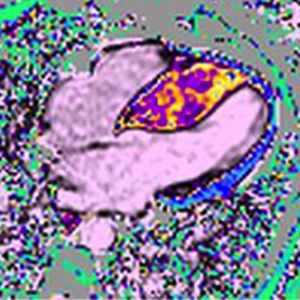Early diagnosis of cardiomyopathies by cardiac magnetic resonance. Overview of the main criteria

Submitted: February 28, 2022
Accepted: March 15, 2022
Published: April 11, 2022
Accepted: March 15, 2022
Abstract Views: 1449
PDF: 589
Publisher's note
All claims expressed in this article are solely those of the authors and do not necessarily represent those of their affiliated organizations, or those of the publisher, the editors and the reviewers. Any product that may be evaluated in this article or claim that may be made by its manufacturer is not guaranteed or endorsed by the publisher.
All claims expressed in this article are solely those of the authors and do not necessarily represent those of their affiliated organizations, or those of the publisher, the editors and the reviewers. Any product that may be evaluated in this article or claim that may be made by its manufacturer is not guaranteed or endorsed by the publisher.
Similar Articles
- Elio Gorga, Marta Scodro, Francesca Valentini, Renzo D'Ortona, Mariachiara Arisi, Edoardo Sciatti, Ivano Bonadei, Valentina Regazzoni, Enrico Vizzardi, Marco Metra, Piergiacomo Calzavara Pinton, Echocardiographic evaluation of diastolic dysfunction in young and healthy patients with psoriasis: A case-control study , Monaldi Archives for Chest Disease: Vol. 88 No. 3 (2018)
- Roberto F.E. Pedretti, Francesco Fattirolli, Raffaele Griffo, Marco Ambrosetti, Elisabetta Angelino, Silvia Brazzo, Ugo Corrà , Nicolò Dasseni, Pompilio Faggiano, Giuseppe Favretto, Oreste Febo, Marina Ferrari, Francesco Giallauria, Cesare Greco, Manuela Iannucci, Maria Teresa La Rovere, Mario Mallardo, Antonio Mazza, Massimo Piepoli, Carmine Riccio, Simonetta Scalvini, Luigi Tavazzi, Pier Luigi Temporelli, Gian Francesco Mureddu, Cardiac Prevention and Rehabilitation “3.0â€: From acute to chronic phase. Position Paper of the ltalian Association for Cardiovascular Prevention and Rehabilitation (GICR-IACPR) , Monaldi Archives for Chest Disease: Vol. 88 No. 3 (2018)
- Sotirios D. Moraitis, Apostolos C. Agrafiotis, Dimitrios Pappas, Chrysovalantis Pothitakis, Maria Stergianni, Ioannis Koukis, Thymic pathology and cardiac myxomas: Coincidence or a closer relationship? , Monaldi Archives for Chest Disease: Vol. 88 No. 1 (2018)
- Concezione Tommasino, Cardiovascular risk assessment in the senior population undergoing anesthesia for non-cardiac surgery , Monaldi Archives for Chest Disease: Vol. 87 No. 2 (2017)
- Marzia Vassalini, Andrea Verzeletti, Francesco De Ferrari, Standard of care and guidelines in prevention and diagnosis of venous thromboembolism: medico-legal implications , Monaldi Archives for Chest Disease: Vol. 84 No. 1-2 (2015): Cardiac series
- Floriana Caccamo, Simone Saltini, Enrico Carella, Roberto Carlon, Cristina Marogna, Vito Sava, The measure of effectiveness of a short-term 2-week intensive Cardiac Rehabilitation program in decreasing levels of anxiety and depression , Monaldi Archives for Chest Disease: Vol. 88 No. 1 (2018)
- Domenico Galzerano, Claudio Pragliola, Mohamed Al Admawi, Mario Mallardo, Sara Di Michele, Carlo Gaudio, The role of 3D echocardiographic imaging in the differential diagnosis of an atypical left atrial myxoma , Monaldi Archives for Chest Disease: Vol. 88 No. 3 (2018)
- Raffaele Griffo, Francesco Fattirolli, Pier Luigi Temporelli, Roberto Tramarin, Italian survey on CArdiac RehabilitatiOn and Secondary prevention after cardiac revascularization: ICAROS study. A survey from the italian cardiac rehabilitation network: rationale and design , Monaldi Archives for Chest Disease: Vol. 70 No. 3 (2008): Cardiac series
- Rodolfo Citro, Antonello Panza, Paolo Masiello, Amelia Ravera, Lucia Tedesco, Rocco Leone, Marco Mirra, Roberta Giudice, Severino Iesu, Francesco Silvestri, Giuseppe Di Benedetto, Eduardo Bossone, Intramural aortic hematoma: no flap no warning? , Monaldi Archives for Chest Disease: Vol. 76 No. 1 (2011): Cardiac series
- Francesco Giallauria, Rosa Lucci, Francesco Pilerci, Anna De Lorenzo, Athanasio Manakos, Marianna Psaroudaki, Mariantonietta D’Agostino, Alessandra Vitelli, Luigi Maresca, Domenico Del Forno, Carlo Vigorito, Efficacy of Telecardiology in improving the results of Cardiac Rehabilitation after acute myocardial infarction , Monaldi Archives for Chest Disease: Vol. 66 No. 1 (2006): Cardiac series
You may also start an advanced similarity search for this article.

 https://doi.org/10.4081/monaldi.2022.2151
https://doi.org/10.4081/monaldi.2022.2151





